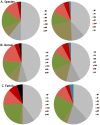Nematode spatial and ecological patterns from tropical and temperate rainforests
- PMID: 22984536
- PMCID: PMC3439412
- DOI: 10.1371/journal.pone.0044641
Nematode spatial and ecological patterns from tropical and temperate rainforests
Abstract
Large scale diversity patterns are well established for terrestrial macrobiota (e.g. plants and vertebrates), but not for microscopic organisms (e.g. nematodes). Due to small size, high abundance, and extensive dispersal, microbiota are assumed to exhibit cosmopolitan distributions with no biogeographical patterns. This assumption has been extrapolated from local spatial scale studies of a few taxonomic groups utilizing morphological approaches. Recent molecularly-based studies, however, suggest something quite opposite. Nematodes are the most abundant metazoans on earth, but their diversity patterns are largely unknown. We conducted a survey of nematode diversity within three vertical strata (soil, litter, and canopy) of rainforests at two contrasting latitudes in the North American meridian (temperate: the Olympic National Forest, WA, U.S.A and tropical: La Selva Biological Station, Costa Rica) using standardized sampling designs and sample processing protocols. To describe nematode diversity, we applied an ecometagenetic approach using 454 pyrosequencing. We observed that: 1) nematode communities were unique without even a single common species between the two rainforests, 2) nematode communities were unique among habitats in both rainforests, 3) total species richness was 300% more in the tropical than in the temperate rainforest, 4) 80% of the species in the temperate rainforest resided in the soil, whereas only 20% in the tropics, 5) more than 90% of identified species were novel. Overall, our data provided no support for cosmopolitanism at both local (habitats) and large (rainforests) spatial scales. In addition, our data indicated that biogeographical patterns typical of macrobiota also exist for microbiota.
Conflict of interest statement
Figures





Similar articles
-
Ecometagenetics confirm high tropical rainforest nematode diversity.Mol Ecol. 2010 Dec;19(24):5521-30. doi: 10.1111/j.1365-294X.2010.04891.x. Epub 2010 Nov 4. Mol Ecol. 2010. PMID: 21054606
-
Tropical nematode diversity: vertical stratification of nematode communities in a Costa Rican humid lowland rainforest.Mol Ecol. 2009 Mar;18(5):985-96. doi: 10.1111/j.1365-294X.2008.04075.x. Mol Ecol. 2009. PMID: 19207247
-
Hydroids (Cnidaria, Hydrozoa) from Mauritanian Coral Mounds.Zootaxa. 2020 Nov 16;4878(3):zootaxa.4878.3.2. doi: 10.11646/zootaxa.4878.3.2. Zootaxa. 2020. PMID: 33311142
-
South American palaeobotany and the origins of neotropical rainforests.Philos Trans R Soc Lond B Biol Sci. 2004 Oct 29;359(1450):1595-610. doi: 10.1098/rstb.2004.1531. Philos Trans R Soc Lond B Biol Sci. 2004. PMID: 15519975 Free PMC article. Review.
-
Metacommunity theory and its application in community ecology of nematodes.Ying Yong Sheng Tai Xue Bao. 2025 May;36(5):1590-1598. doi: 10.13287/j.1001-9332.202505.032. Ying Yong Sheng Tai Xue Bao. 2025. PMID: 40456661 Review. English.
Cited by
-
Nematode Fauna of Tropical Rainforest in Brazil: A Descriptive and Seasonal Approach.J Nematol. 2016 Jun;48(2):116-25. doi: 10.21307/jofnem-2017-017. J Nematol. 2016. PMID: 27418705 Free PMC article.
-
High-throughput metabarcoding reveals the effect of physicochemical soil properties on soil and litter biodiversity and community turnover across Amazonia.PeerJ. 2018 Sep 25;6:e5661. doi: 10.7717/peerj.5661. eCollection 2018. PeerJ. 2018. PMID: 30280033 Free PMC article.
-
Paradigm of plant invasion: multifaceted review on sustainable management.Environ Monit Assess. 2015 Dec;187(12):759. doi: 10.1007/s10661-015-4934-3. Epub 2015 Nov 18. Environ Monit Assess. 2015. PMID: 26581605 Review.
-
Soil nematode functional diversity, successional patterns, and indicator taxa associated with vertebrate decomposition hotspots.PLoS One. 2020 Nov 4;15(11):e0241777. doi: 10.1371/journal.pone.0241777. eCollection 2020. PLoS One. 2020. PMID: 33147264 Free PMC article.
-
High-throughput sequencing of nematode communities from total soil DNA extractions.BMC Ecol. 2015 Feb 12;15:3. doi: 10.1186/s12898-014-0034-4. BMC Ecol. 2015. PMID: 25880249 Free PMC article.
References
-
- Baas Becking LGM (1934) Geobiologie of inleiding tot de milieukunde. VP Van Stockkum & Zoon, The Hague, The Netherlands.
-
- Finlay BJ (2002) Global dispersal of free-living microbial eukaryote species. Science 296: 1061–1063. - PubMed
-
- Fenchel T, Finlay BJ (2004) The ubiquity of small species: patterns of local and global diversity. BioScience 54: 777–784.
-
- Finlay BJ, Corliss JO, Esteban G, Fenchel T (1996) Biodiversity at the microbial level: The number of free-living ciliates in the biosphere. Quart Rev Biol 71: 221–237.
-
- Fenchel T, Esteban GF, Finlay BJ (1997) Local vs. global diversity of microorganisms: Cryptic diversity of ciliated protozoa. Oikos 80: 220–225.
Publication types
MeSH terms
Substances
LinkOut - more resources
Full Text Sources

